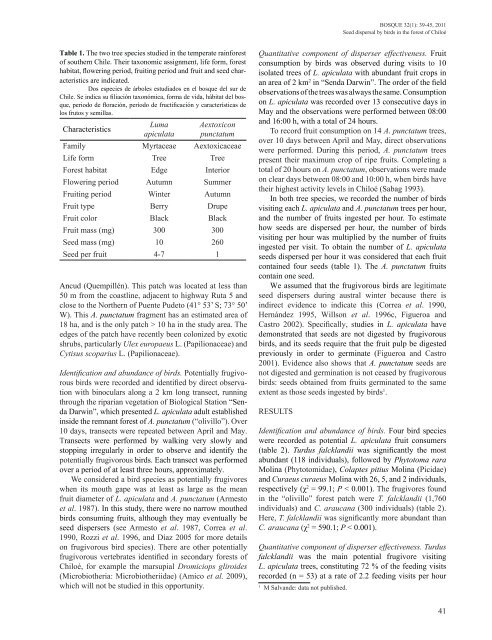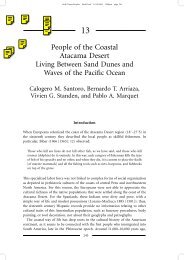Quantity component of the effectiveness of seed dispersal by birds in ...
Quantity component of the effectiveness of seed dispersal by birds in ...
Quantity component of the effectiveness of seed dispersal by birds in ...
Create successful ePaper yourself
Turn your PDF publications into a flip-book with our unique Google optimized e-Paper software.
BOSQUE 32(1): 39-45, 2011Seed <strong>dispersal</strong> <strong>by</strong> <strong>birds</strong> <strong>in</strong> <strong>the</strong> forest <strong>of</strong> ChiloéTable 1. The two tree species studied <strong>in</strong> <strong>the</strong> temperate ra<strong>in</strong>forest<strong>of</strong> sou<strong>the</strong>rn Chile. Their taxonomic assignment, life form, foresthabitat, flower<strong>in</strong>g period, fruit<strong>in</strong>g period and fruit and <strong>seed</strong> characteristicsare <strong>in</strong>dicated.Dos especies de árboles estudiados en el bosque del sur deChile. Se <strong>in</strong>dica su filiación taxonómica, forma de vida, hábitat del bosque,periodo de floración, período de fructificación y características delos frutos y semillas.CharacteristicsLumaapiculataAextoxiconpunctatumFamily Myrtaceae AextoxicaceaeLife form Tree TreeForest habitat Edge InteriorFlower<strong>in</strong>g period Autumn SummerFruit<strong>in</strong>g period W<strong>in</strong>ter AutumnFruit type Berry DrupeFruit color Black BlackFruit mass (mg) 300 300Seed mass (mg) 10 260Seed per fruit 4-7 1Ancud (Quempillén). This patch was located at less than50 m from <strong>the</strong> coastl<strong>in</strong>e, adjacent to highway Ruta 5 andclose to <strong>the</strong> Nor<strong>the</strong>rn <strong>of</strong> Puente Pudeto (41° 53’ S; 73° 50’W). This A. punctatum fragment has an estimated area <strong>of</strong>18 ha, and is <strong>the</strong> only patch > 10 ha <strong>in</strong> <strong>the</strong> study area. Theedges <strong>of</strong> <strong>the</strong> patch have recently been colonized <strong>by</strong> exoticshrubs, particularly Ulex europaeus L. (Papilionaceae) andCytisus scoparius L. (Papilionaceae).Identification and abundance <strong>of</strong> <strong>birds</strong>. Potentially frugivorous<strong>birds</strong> were recorded and identified <strong>by</strong> direct observationwith b<strong>in</strong>oculars along a 2 km long transect, runn<strong>in</strong>gthrough <strong>the</strong> riparian vegetation <strong>of</strong> Biological Station “SendaDarw<strong>in</strong>”, which presented L. apiculata adult established<strong>in</strong>side <strong>the</strong> remnant forest <strong>of</strong> A. punctatum (“olivillo”). Over10 days, transects were repeated between April and May.Transects were performed <strong>by</strong> walk<strong>in</strong>g very slowly andstopp<strong>in</strong>g irregularly <strong>in</strong> order to observe and identify <strong>the</strong>potentially frugivorous <strong>birds</strong>. Each transect was performedover a period <strong>of</strong> at least three hours, approximately.We considered a bird species as potentially frugivoreswhen its mouth gape was at least as large as <strong>the</strong> meanfruit diameter <strong>of</strong> L. apiculata and A. punctatum (Armestoet al. 1987). In this study, <strong>the</strong>re were no narrow mou<strong>the</strong>d<strong>birds</strong> consum<strong>in</strong>g fruits, although <strong>the</strong>y may eventually be<strong>seed</strong> dispersers (see Armesto et al. 1987, Correa et al.1990, Rozzi et al. 1996, and Díaz 2005 for more detailson frugivorous bird species). There are o<strong>the</strong>r potentiallyfrugivorous vertebrates identified <strong>in</strong> secondary forests <strong>of</strong>Chiloé, for example <strong>the</strong> marsupial Dromiciops gliroides(Microbio<strong>the</strong>ria: Microbio<strong>the</strong>riidae) (Amico et al. 2009),which will not be studied <strong>in</strong> this opportunity.Quantitative <strong>component</strong> <strong>of</strong> disperser <strong>effectiveness</strong>. Fruitconsumption <strong>by</strong> <strong>birds</strong> was observed dur<strong>in</strong>g visits to 10isolated trees <strong>of</strong> L. apiculata with abundant fruit crops <strong>in</strong>an area <strong>of</strong> 2 km 2 <strong>in</strong> “Senda Darw<strong>in</strong>”. The order <strong>of</strong> <strong>the</strong> fieldobservations <strong>of</strong> <strong>the</strong> trees was always <strong>the</strong> same. Consumptionon L. apiculata was recorded over 13 consecutive days <strong>in</strong>May and <strong>the</strong> observations were performed between 08:00and 16:00 h, with a total <strong>of</strong> 24 hours.To record fruit consumption on 14 A. punctatum trees,over 10 days between April and May, direct observationswere performed. Dur<strong>in</strong>g this period, A. punctatum treespresent <strong>the</strong>ir maximum crop <strong>of</strong> ripe fruits. Complet<strong>in</strong>g atotal <strong>of</strong> 20 hours on A. punctatum, observations were madeon clear days between 08:00 and 10:00 h, when <strong>birds</strong> have<strong>the</strong>ir highest activity levels <strong>in</strong> Chiloé (Sabag 1993).In both tree species, we recorded <strong>the</strong> number <strong>of</strong> <strong>birds</strong>visit<strong>in</strong>g each L. apiculata and A. punctatum trees per hour,and <strong>the</strong> number <strong>of</strong> fruits <strong>in</strong>gested per hour. To estimatehow <strong>seed</strong>s are dispersed per hour, <strong>the</strong> number <strong>of</strong> <strong>birds</strong>visit<strong>in</strong>g per hour was multiplied <strong>by</strong> <strong>the</strong> number <strong>of</strong> fruits<strong>in</strong>gested per visit. To obta<strong>in</strong> <strong>the</strong> number <strong>of</strong> L. apiculata<strong>seed</strong>s dispersed per hour it was considered that each fruitconta<strong>in</strong>ed four <strong>seed</strong>s (table 1). The A. punctatum fruitsconta<strong>in</strong> one <strong>seed</strong>.We assumed that <strong>the</strong> frugivorous <strong>birds</strong> are legitimate<strong>seed</strong> dispersers dur<strong>in</strong>g austral w<strong>in</strong>ter because <strong>the</strong>re is<strong>in</strong>direct evidence to <strong>in</strong>dicate this (Correa et al. 1990,Hernández 1995, Willson et al. 1996c, Figueroa andCastro 2002). Specifically, studies <strong>in</strong> L. apiculata havedemonstrated that <strong>seed</strong>s are not digested <strong>by</strong> frugivorous<strong>birds</strong>, and its <strong>seed</strong>s require that <strong>the</strong> fruit pulp be digestedpreviously <strong>in</strong> order to germ<strong>in</strong>ate (Figueroa and Castro2001). Evidence also shows that A. punctatum <strong>seed</strong>s arenot digested and germ<strong>in</strong>ation is not ceased <strong>by</strong> frugivorous<strong>birds</strong>: <strong>seed</strong>s obta<strong>in</strong>ed from fruits germ<strong>in</strong>ated to <strong>the</strong> sameextent as those <strong>seed</strong>s <strong>in</strong>gested <strong>by</strong> <strong>birds</strong> 1 .RESULTSIdentification and abundance <strong>of</strong> <strong>birds</strong>. Four bird specieswere recorded as potential L. apiculata fruit consumers(table 2). Turdus falcklandii was significantly <strong>the</strong> mostabundant (118 <strong>in</strong>dividuals), followed <strong>by</strong> Phytotoma raraMol<strong>in</strong>a (Phytotomidae), Colaptes pitius Mol<strong>in</strong>a (Picidae)and Curaeus curaeus Mol<strong>in</strong>a with 26, 5, and 2 <strong>in</strong>dividuals,respectively (χ 2 = 99.1; P < 0.001). The frugivores found<strong>in</strong> <strong>the</strong> “olivillo” forest patch were T. falcklandii (1,760<strong>in</strong>dividuals) and C. araucana (300 <strong>in</strong>dividuals) (table 2).Here, T. falcklandii was significantly more abundant thanC. araucana (χ 2 = 590.1; P < 0.001).Quantitative <strong>component</strong> <strong>of</strong> disperser <strong>effectiveness</strong>. Turdusfalcklandii was <strong>the</strong> ma<strong>in</strong> potential frugivore visit<strong>in</strong>gL. apiculata trees, constitut<strong>in</strong>g 72 % <strong>of</strong> <strong>the</strong> feed<strong>in</strong>g visitsrecorded (n = 53) at a rate <strong>of</strong> 2.2 feed<strong>in</strong>g visits per hour1M Salvande: data not published.41
















